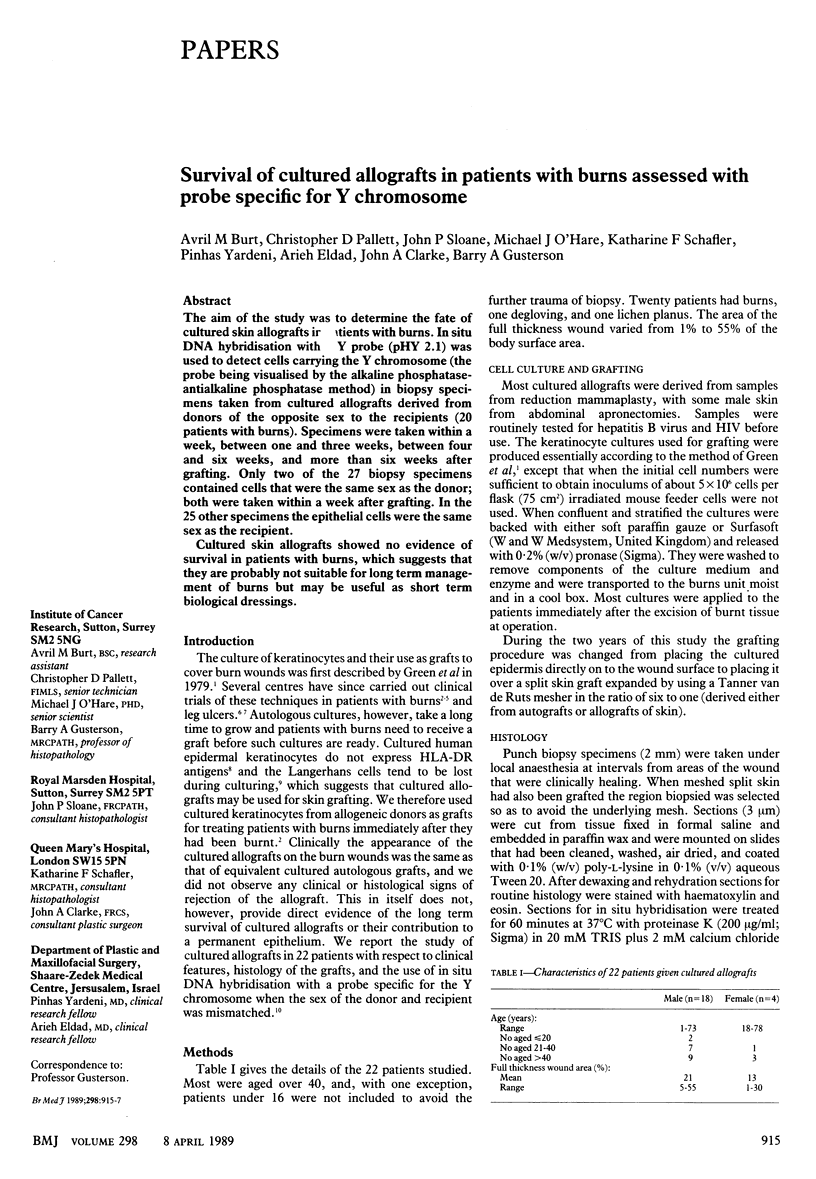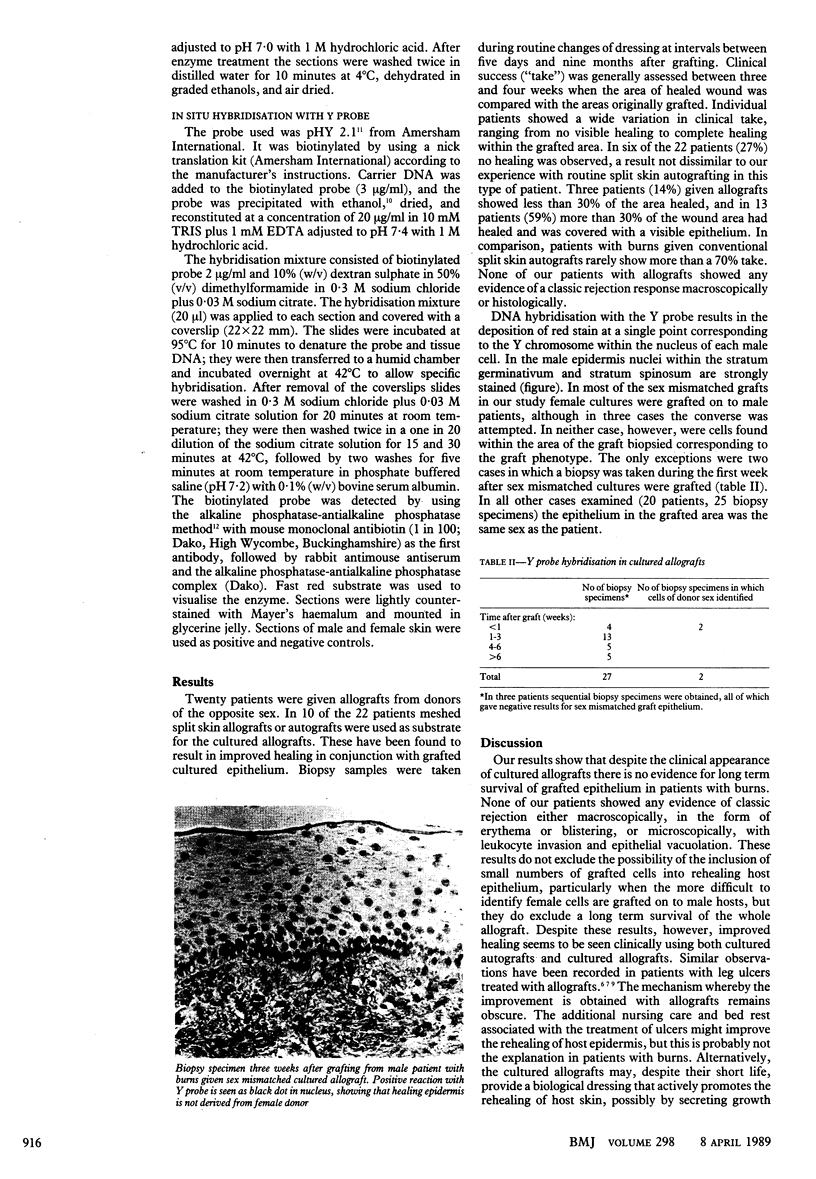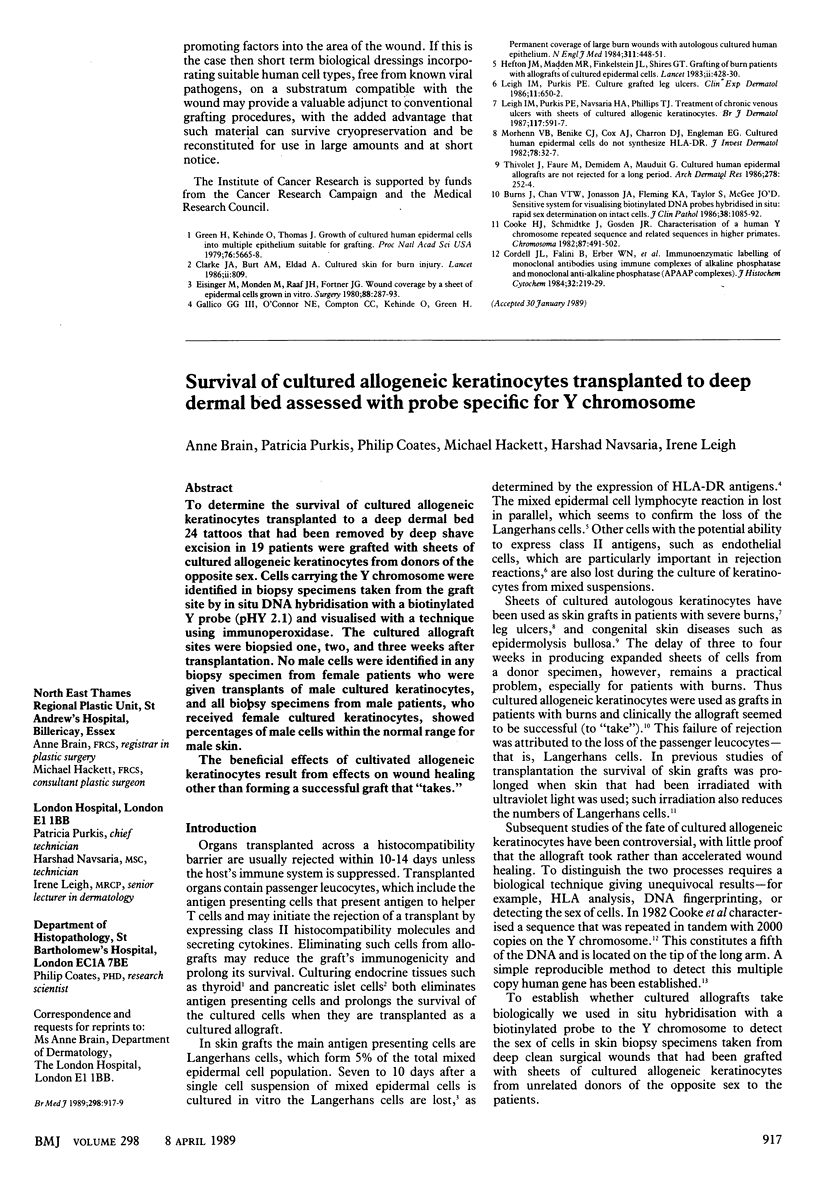Abstract
The aim of the study was to determine the fate of cultured skin allografts in patients with burns. In situ DNA hybridisation with a Y probe (pHY 2.1) was used to detect cells carrying the Y chromosome (the probe being visualised by the alkaline phosphatase-antialkaline phosphatase method) in biopsy specimens taken from cultured allografts derived from donors of the opposite sex to the recipients (20 patients with burns). Specimens were taken within a week, between one and three weeks, between four and six weeks, and more than six weeks after grafting. Only two of the 27 biopsy specimens contained cells that were the same sex as the donor; both were taken within a week after grafting. In the 25 other specimens the epithelial cells were the same sex as the recipient. Cultured skin allografts showed no evidence of survival in patients with burns, which suggests that they are probably not suitable for long term management of burns but may be useful as short term biological dressings.
Full text
PDF


Images in this article
Selected References
These references are in PubMed. This may not be the complete list of references from this article.
- Burns J., Chan V. T., Jonasson J. A., Fleming K. A., Taylor S., McGee J. O. Sensitive system for visualising biotinylated DNA probes hybridised in situ: rapid sex determination of intact cells. J Clin Pathol. 1985 Oct;38(10):1085–1092. doi: 10.1136/jcp.38.10.1085. [DOI] [PMC free article] [PubMed] [Google Scholar]
- Clarke J. A., Burt A. M., Eldad A., Gusterson B. A. Cultured skin for burn injury. Lancet. 1986 Oct 4;2(8510):809–809. doi: 10.1016/s0140-6736(86)90326-0. [DOI] [PubMed] [Google Scholar]
- Cooke H. J., Schmidtke J., Gosden J. R. Characterisation of a human Y chromosome repeated sequence and related sequences in higher primates. Chromosoma. 1982;87(5):491–502. doi: 10.1007/BF00333470. [DOI] [PubMed] [Google Scholar]
- Cordell J. L., Falini B., Erber W. N., Ghosh A. K., Abdulaziz Z., MacDonald S., Pulford K. A., Stein H., Mason D. Y. Immunoenzymatic labeling of monoclonal antibodies using immune complexes of alkaline phosphatase and monoclonal anti-alkaline phosphatase (APAAP complexes). J Histochem Cytochem. 1984 Feb;32(2):219–229. doi: 10.1177/32.2.6198355. [DOI] [PubMed] [Google Scholar]
- Eisinger M., Monden M., Raaf J. H., Fortner J. G. Wound coverage by a sheet of epidermal cells grown in vitro from dispersed single cell preparations. Surgery. 1980 Aug;88(2):287–293. [PubMed] [Google Scholar]
- Gallico G. G., 3rd, O'Connor N. E., Compton C. C., Kehinde O., Green H. Permanent coverage of large burn wounds with autologous cultured human epithelium. N Engl J Med. 1984 Aug 16;311(7):448–451. doi: 10.1056/NEJM198408163110706. [DOI] [PubMed] [Google Scholar]
- Green H., Kehinde O., Thomas J. Growth of cultured human epidermal cells into multiple epithelia suitable for grafting. Proc Natl Acad Sci U S A. 1979 Nov;76(11):5665–5668. doi: 10.1073/pnas.76.11.5665. [DOI] [PMC free article] [PubMed] [Google Scholar]
- Hefton J. M., Madden M. R., Finkelstein J. L., Shires G. T. Grafting of burn patients with allografts of cultured epidermal cells. Lancet. 1983 Aug 20;2(8347):428–430. doi: 10.1016/s0140-6736(83)90392-6. [DOI] [PubMed] [Google Scholar]
- Leigh I. M., Purkis P. E. Culture grafted leg ulcers. Clin Exp Dermatol. 1986 Nov;11(6):650–652. doi: 10.1111/j.1365-2230.1986.tb00526.x. [DOI] [PubMed] [Google Scholar]
- Leigh I. M., Purkis P. E., Navsaria H. A., Phillips T. J. Treatment of chronic venous ulcers with sheets of cultured allogenic keratinocytes. Br J Dermatol. 1987 Nov;117(5):591–597. doi: 10.1111/j.1365-2133.1987.tb07491.x. [DOI] [PubMed] [Google Scholar]
- Morhenn V. B., Benike C. J., Cox A. J., Charron D. J., Engleman E. G. Cultured human epidermal cells do not synthesize HLA-DR. J Invest Dermatol. 1982 Jan;78(1):32–37. doi: 10.1111/1523-1747.ep12497875. [DOI] [PubMed] [Google Scholar]
- Thivolet J., Faure M., Demidem A., Mauduit G. Cultured human epidermal allografts are not rejected for a long period. Arch Dermatol Res. 1986;278(3):252–254. doi: 10.1007/BF00412936. [DOI] [PubMed] [Google Scholar]



